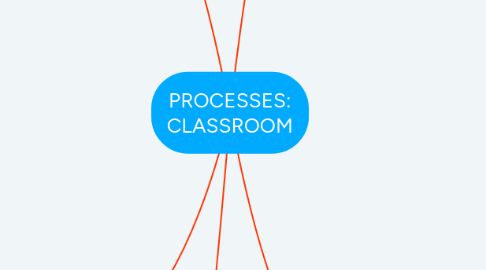
1. CLASSROOM MANAGEMENT
1.1. Warning Tracking Checklist
1.2. Use of Expectations Poster
1.3. Brain Breaks
1.3.1. For 2-3min
1.3.2. Every 20-30 min
1.4. 1. Non-verbal warning
1.5. 2. Verbal warning (with redirection to Expectations Poster)
1.5.1. Back to teaching
1.6. 3. Second warning (with redirection to Expectations Poster)
1.6.1. Back to teaching
1.7. 4. Ask to wait after class
1.7.1. Back to teaching
1.8. 5. Request to move seats
1.8.1. Back to teaching
1.9. 6. Notify leadership
1.9.1. Pause teaching
1.9.2. Severe disruptions
1.10. No asking students to stand outside classroom or leave
1.11. No getting caught-up in arguments with students
1.12. No long lectures to whole class on behaviour
2. PROCEDURES
2.1. Getting Attention
2.1.1. Decide on your attention procedure
2.1.2. Do not start without full attention
2.2. Setting Homework
2.2.1. Write up HW on the board
2.2.2. Request students take notes in the College Diary with due date
2.3. Teamwork
2.3.1. Set up teams strategically
2.3.2. Define the teamwork protocols
2.3.3. Make sure protocols are adhered to
2.4. Request Permission to Leave
2.4.1. Water
2.4.2. Toilet
2.4.3. Sickbay
2.4.4. Office
2.4.5. Library
2.5. Engagement Interactions
2.5.1. Time-out in Class
2.5.1.1. Move to another table
2.5.1.2. Move to the front row table
2.5.2. After class Chat
2.5.2.1. Speaking succintly
2.5.2.2. Indicating next step is LTD
3. TRACKING PROGRESS
3.1. Academic Progress
3.1.1. Tests and quizzes
3.1.2. Assignments and projects
3.1.3. Homework
3.2. In-Class Engagement and Behaviour
3.2.1. Positive Behaviours
3.2.2. Negative Behaviours
3.2.3. Tracking sheet/Chronicle/SEQTA
3.3. Approaches to Learning
3.3.1. Use of class time
3.3.2. Effort shown
3.3.3. Bringing materials to class
3.3.4. Meeting deadlines
3.4. Tools
3.4.1. Assessment files
3.4.1.1. T:\0.2018 CURRICULUM DOCUMENTS
3.4.2. Chronicle
3.4.3. SEQTA
4. ENVIRONMENT
4.1. Turn off projector/screen
4.2. Clean whiteboard
4.3. Tidy teacher's table/bench
4.4. Open window blinds/shades
4.5. Close windows
4.6. Turn off fans/heater/airconditioner
4.7. Turn off lights
4.8. Lock doors
4.9. Emergency exit
4.9.1. Not to be used
4.9.1.1. except in an emergency
4.9.2. Closed all the time
4.9.3. Not to be used to leave at the end of day
4.10. Students
4.10.1. Tables organised
4.10.2. Chairs in
4.10.3. Papers off floor
5. LESSON FLOW
5.1. Pre-Lesson
5.1.1. Write on board
5.1.1.1. Topic Title
5.1.1.2. Date
5.1.1.3. Plan/outline
5.1.2. Learning Intentions
5.1.2.1. Write on board
5.1.2.2. Display on poster
5.1.2.3. Distribute on A4 sheet
5.2. Start of Lesson
5.2.1. Mark attendance on SEQTA roll
5.2.2. Communicate structure
5.2.2.1. Make connections for students
5.2.2.2. How does this lesson fit in with previous lesson
5.2.2.3. How does it link to current unit of work
5.2.3. Start with tuning-in activity
5.3. During Lesson
5.3.1. Teach in 10-15min chunks
5.3.2. Pause and check for understanding
5.3.3. Adjust lesson flow accordingly
5.3.4. Brain break if needed (mid way)
5.4. End of Lesson
5.4.1. Recap and review with exit activity
5.4.2. Look ahead
5.4.2.1. How will the next lesson follow from this lesson
5.4.3. Evaluate and reflect on how the lesson went
5.4.4. Set homework / assessment deadlines
5.4.4.1. on board
5.4.4.2. students to note in diary
5.5. Lesson Types
5.5.1. Direct instruction
5.5.1.1. New content learning
5.5.1.2. Whole class focused structured learning
5.5.2. Collaborative Teamwork / Group Work
5.5.2.1. To deepen understanding
5.5.2.1.1. To review learning
5.5.2.2. Semi-structured Group Autonomy
5.5.2.3. Periodic on task checks
5.5.3. Self-Study / Individual Work
5.5.3.1. To review and deepen understanding
5.5.3.2. To practice self-disciplined independent study
5.5.3.3. To prepare for assessments
5.5.3.4. Individual Autonomy
5.5.3.4.1. On task checks
